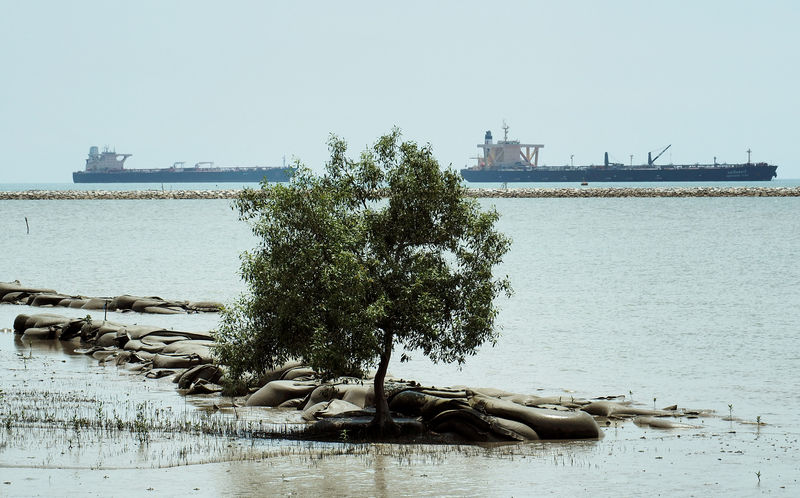By Henning Gloystein and Yuka Obayashi
SINGAPORE/TOKYO (Reuters) - For the first time since 2008, OPEC is set to strike a deal to cut oil output that may boost prices. It may also give itself a bloody nose in Asia, where big buyers are ramping up supplies from elsewhere and say they don't want to pay more for fuel.
The Organization of Petroleum Exporting Countries (OPEC) meets on Wednesday to hammer out a deal to prop up prices (LCOc1) that have halved since 2014. As they gather, tanker shipments to Asia from non-OPEC sources like Alaska, Azerbaijan, and the North Sea are growing, according to shipping data in Thomson Reuters Eikon. (http://tmsnrt.rs/2fvsKBo)
Buyers in Asia, which alone uses a third of the world's oil supply, have watched with concern as OPEC suppliers - their biggest - openly discuss propping up prices. With non-OPEC supplies readily available, they say they'll consider exploring new sources if the cartel's price is no longer right.
"For us, the current price levels look to be appropriate for both sides (buyers and producers)," said Eiichiro Kitahara, Executive Officer at major Japanese refinery TonenGeneral Sekiyu (T:5012).
"Our company aims to avoid depending highly on certain suppliers, and we may seek new (supply) opportunities," Kitahara said, though like other executives he cautioned against expectations of any sudden change in supply trends among buyers.
Major importers in Japan, China and South Korea have long-standing relationships with OPEC suppliers, with just its Middle East members providing two-thirds of Asia's oil needs.
Those ties could loosen, with refiners in countries like Japan - which gets around 90 percent of its oil from Middle East OPEC-members - keen to diversify sources to cut reliance on any single supplier.
In China, now challenging the United States as the world's biggest oil importer, efforts to reduce dependence on Middle East supplies have already seen OPEC kingpin Saudi Arabia lose its no.1 supplier rank to its rival Russia. Eikon data shows Middle East producers' share of China's supply market fell from 50 percent in January to 46 percent in November.
PRICE - THE BOTTOM LINE
Oil markets remained jittery ahead of the OPEC meeting.
But refiners across Asia remain alive to the prospects of shifting market dynamics and how they could make other suppliers more attractive, even as OPEC seeks a price rise to boost the economies of countries that rely heavily on crude exports.
"We are closely monitoring the OPEC meeting," said Kim Woo-Kyung, a spokeswoman at major South Korean refiner SK Innovation (KS:096770). "Even if OPEC cuts output, it won't have a big impact (on SK Innovation business) as there are a lot of supplies out there."
Despite Asia's openness to new suppliers, price remains the ultimate arbiter.
Most Middle Eastern crudes cost between $45 and $48 per barrel - ahead of any production cut accord - a competitive price versus supplies from elsewhere when shipping fees are included.
North Sea crudes like Britain's Brent and Forties, or Norway's Oseberg, cost between $46 and almost $47 a barrel, Azeri Light crude is currently priced at over $48, while Alaska North Slope crude is on the market for $46.30 per barrel.
Fatih Birol, Executive Director of the International Energy Agency (IEA), which represents interests of oil consumers, told Reuters at a conference in Tokyo that an OPEC cut designed to raise prices could trigger an increase in output by other producers elsewhere - an increase in supply that could end up pegging prices back.
"If prices are pushed up towards $60 we will see within nine months a strong response from U.S. shale production putting oil in the market," Birol said.
OIL TO ASIA
In the United States, suppliers are poised to take advantage of any shift in buying patterns.
"Asian (oil) dependence on the Middle East is higher than they are comfortable with," said Bill Walker, Governor of Alaska, speaking during a recent visit to Japan. "They'd like to see something coming out of the U.S. We have seen some shipments come over (to Asia) and I think we are going to see more."
"Our location is an advantage. It's seven days of transit (to Japan)," he added, compared with around three weeks it takes to get Middle East oil to Japan.
U.S. crude supplies to Asia from Alaska remain rare, but they have gradually picked up this year - after years of strict government restrictions on oil exports ended. Last month, BP (L:BP) sold its first shipment U.S. crude to Thailand and Australia.
Another exporter seeking to place more oil into Asia is Azerbaijan. The mid-sized producer pumps under 900,000 barrels of crude per day - and isn't a member of OPEC.
Eikon trade flows show almost 7 million barrels of Azeri Light crude were loaded for Asia in October, bound for mainland China, Taiwan and India - the highest volume since records began in January 2015.

Shipping data also shows large amounts of North Sea oil - especially British Forties grade crude - currently aboard supertankers heading for northeast Asia. North Sea crude oil flows to the region as a whole have jumped, with 10.7 million barrels arriving in November, their highest level since December last year, Eikon data shows.